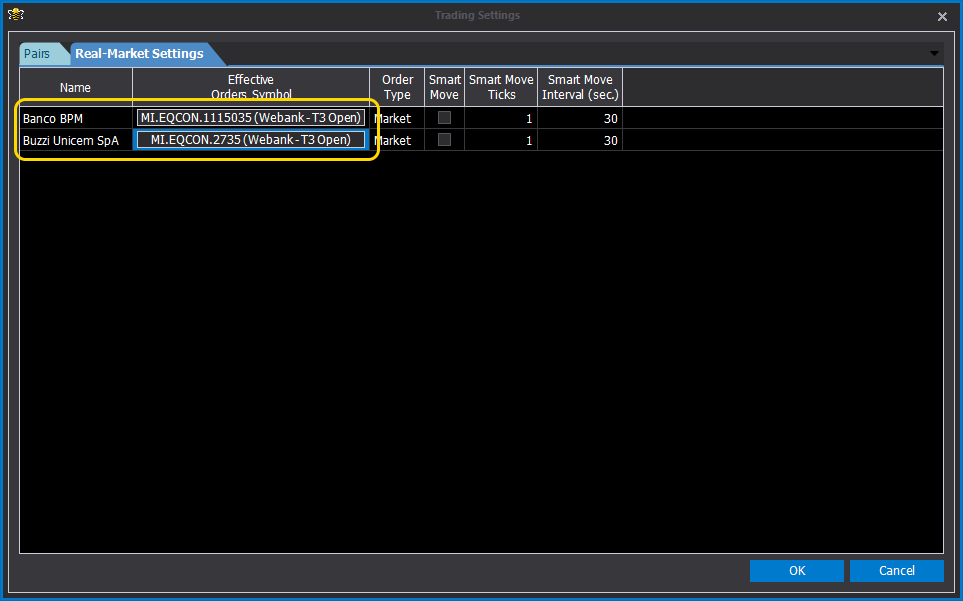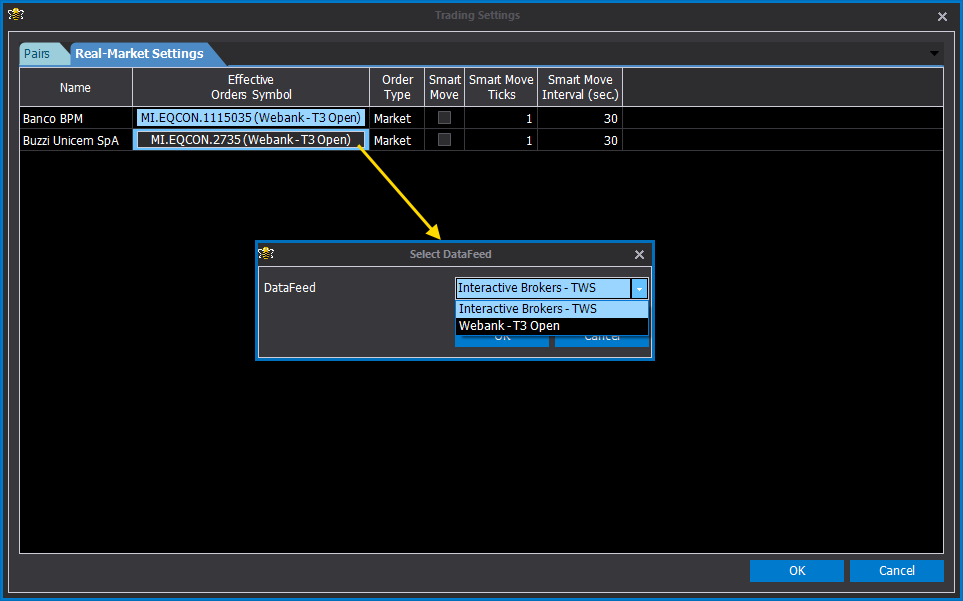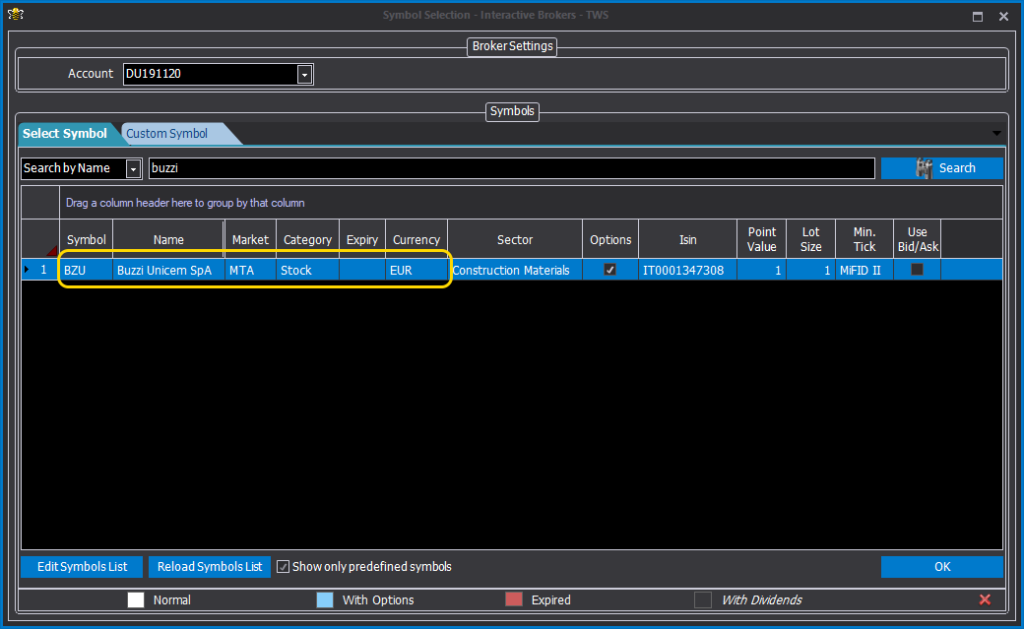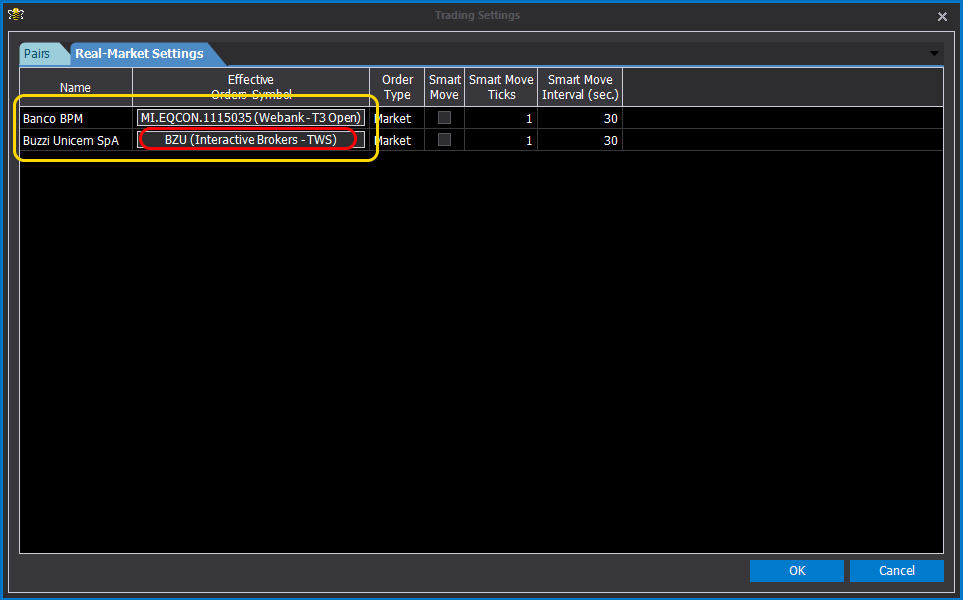OverSpread Trading
Understand the OverSpread Trading function
From the OverSpread Watchlist window you can use the automatic trading features of OverSpread. Three different commands are available:
- Paper Trading: in this case the orders generated by OverSpread will be simulated and no orders will be sent to your broker;
- Real Market: in this case the orders generated by OverSpread will be sent directly to your broker;
- Options Strategies: function not yet available.
Paper Trading
Once the Paper Trading button is clicked, the window appears in which you can make all the necessary settings:
- Paper Trading: check the pairs for which to activate the OverSpread Trading function in Paper Trading. The Enable All and Disable All commands are available with the right mouse button;
- Asset A: name of the first asset of the couple;
- Asset B: name of the second asset of the pair:
- Current Position: current position of the pair. At the beginning it is always Flat, once executed the first order it will become Long or Short;
- Buy Level: set the Z-Score level that will give the Buy signal once the Z-Score has crossed this value (crossover). By default this value is set to -2;
- Sell Level: set the Z-Score level that will give the Sell signal once the Z-Score has gone down (crossunder) this value By default this value is set to +2;
- Flat Level: set the Z-Score level that will give the Flat signal for the pair. By default this value is set to 0;
- Re-Balance%: set the% maximum deviation of the initial asset weights when exceeding which OverSpread Trading intervenes by buying or selling shares to balance the ratio between the weights of the two assets;
- Total Amount: set the total amount in euros that you want to allocate for the couple. The system will divide this amount between the assets that make up the pair based on the relationship between weights. On the right-click menu, useful functions are available to copy an amount to all the other pairs enabled, or to divide the amount specified for all enabled pairs;
- Asset A Amount: this parameter is automatically calculated once the Total Amount is set based on the weight ratio between the two assets;
- Asset B Amount: this parameter is automatically calculated once the Total Amount is set based on the weight ratio between the two assets;
- Email Notification: flag the cell if you want to be notified by e-mail of the execution of an order.
Note: for the Buy Level, Sell Level, Flat Level and Re-Balance% fields, the function for automatically setting the standard parameters or those optimized for the pair is available from the right-click menu.
Real Market
It is worth remembering that the OverSpread Trading function allows you to automatically execute orders directly on the assets that make up the selected pairs. This means that orders will be sent to the Long and Short market, it is recommended to inquire with your broker if this allows you to send short orders on all assets (for example on stocks).
As we shall see later, the OverSpread Watchlist function allows you to send also to different brokers, or to symbols other than those used to calculate the OverSpread Watchlist.
- Real Market: check the pairs for which to activate the OverSpread Trading function in Real Market. The Enable All and Disable All commands are available with the right mouse button;
- Asset A: name of the first asset of the couple;
- Asset B: name of the second asset of the pair:
- Current Position: current position of the pair. At the beginning it is always Flat, once executed the first order it will become Long or Short;
- Buy Level: set the Z-Score level that will give the Buy signal once the Z-Score has crossed this value (crossover). By default this value is set to -2;
- Sell Level: set the Z-Score level that will give the Sell signal once the Z-Score has gone down (crossunder) this value By default this value is set to +2;
- Flat Level: set the Z-Score level that will give the Flat signal for the pair. By default this value is set to 0;
- Re-Balance%: set the% maximum deviation of the initial asset weights when exceeding which OverSpread Trading intervenes by buying or selling shares to balance the ratio between the weights of the two assets;
- Total Amount: set the total amount in euros that you want to allocate for the couple. The system will divide this amount between the assets that make up the pair based on the relationship between weights. On the right-click menu, useful functions are available to copy an amount to all the other pairs enabled, or to divide the amount specified for all enabled pairs;
- Asset A Amount: this parameter is automatically calculated once the Total Amount is set based on the weight ratio between the two assets;
- Asset B Amount: this parameter is automatically calculated once the Total Amount is set based on the weight ratio between the two assets;
- Email Notification: flag the cell if you want to be notified by e-mail of the execution of an order.
Note: for the Buy Level, Sell Level, Flat Level and Re-Balance% fields, the function for automatically setting the standard parameters or those optimized for the pair is available from the right-click menu.
In the Real-Market Settings section there are a number of settings related to orders in Real Market.
All the assets enabled in the “Pairs” section are listed for which it is possible to modify the symbol on which the order will be made. This function can be useful both in the case in which the datafeed used to perform the scan is not a device, and if the broker does not allow to make short orders on shares.
In both cases, beeTrader must first be connected to both necessary brokers. Then simply click on the symbol you want to replace, at which point you are asked to choose the broker and then the symbol.
Replacement Symbol for Asset
We assume that we have been scanned with WeBank, but short on titles is not enabled, so we want to execute short orders on Interactive Brokers

At the start the system proposes the execution of orders according to the symbols and the broker used to do the scan. In the example:
- Banco BPM -> Long on WeBank
- Buzzi Unicem SpA -> Short on WeBank
We hypothesize that the account is not enabled for short on securities.

After connecting beeTrader also to Interactive Brokers (From File – & gt; Connections – & gt; View Connections starts a function that shows all the connected brokers and the number of connections for each broker. In this the user can monitor not to exceed the any limitations of simultaneous connections imposed by some brokers) by clicking on the Buzzi Unicem SpA symbol the system first proposes the choice of the broker.

The list of available assets is presented in Symbol Manager for the broker selected previously ( in Interactive Brokers), let’s select Buzzi Unicem SpA.

As you can see, after having changed the symbol for the asset Buzzi Unicem SpA, the orders on this last one will be executed on Interactive Brokers, while the orders for the Banco BPM asset remain on WeBank.
Now the same procedure must also be done on the other asset (Banco BPM) since during the life of this pair, both assets could be shorted.




